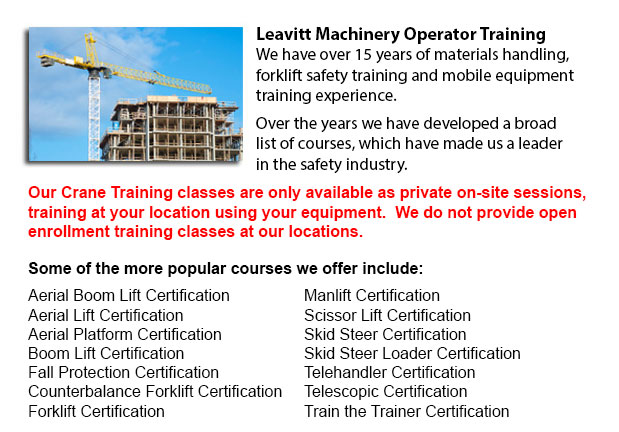
Overhead Crane Safety Training Goodyear - The overhead crane safety training program is meant to equip the operators with the right skills and knowledge in the areas of: crane safety measures, accident avoidance, materials handling, and equipment and stock protection. Each of the trainees would get to learn on numerous types of overhead cranes, their capabilities and their uses in different environments. For operators who are trained and licensed, the shift in liability moves to the operator from the company. Thus, the course emphasizes individual operator duties.
Overhead crane safety training instructs operators in the proper techniques for performing checks. Two kinds of pre-shift inspection are the walk-around inspection and the in-depth inspection. These are important daily routines that should be logged. Properly recorded pre-shift inspections help to protect the company from liability in case of an accident. Pre-shift inspections likewise prevent damage, costly repairs and accidents. Operators learn how to designate a particular individual to perform inspections, how to report problems, and how to maintain the log book.
Checks should be performed on a regular basis and documented right. The following must checked while watching for common problems: increase in the throat opening, hooks for cracks, hoist ropes for corrosion, degree of twist, loss of diameter, worn wires, broken wires, bird caging and kinks, chains for gouges and nicks, chemical and heat damage, twists, corrosion and cracks, distortion, excessive wear, pits, stretching, damage caused by extreme heat.
Operators learn proper rigging procedures in this course. Rigging includes understanding the manufacturer's data plate, determining the weight of materials to be lifted, selecting the gear, and utilizing safe practices to secure the load. The program cover in detail the following: safe working loads, and the capacities of ropes, chains, hooks, shackles and slings.
It is important to understand who could operate the cranes at your facility, the job's physical requirements, and operator qualifications required for specialized job and permits. Safety is a priority when operating near pedestrian traffic.
The duties included in the safe crane operation includes checking for hydraulic leaks, undertaking visual inspections, checking the safety guards, testing the controls, examining the hoist rope and hook, braking mechanisms and limit switches. Correct reporting procedures are critical. These topics are all covered in depth in the program.
The program also covers the proper moving and lifting procedures with hoists and cranes. Operators will also learn right hand signals. Training includes how to attach the load, raise the load, set the load, unhook the slings and abort a lift.
Moving the load includes several steps: starting and stopping procedures, controlling and guiding the load, observing working conditions and working with signals. Operators must know how to proceed in the event of a power failure. The course covers techniques for removing the slings and lowering the load, storage of equipment, parking the crane, and securing an outdoor and indoor crane.
-
Crane / Overhead Crane / Truck Mounted Crane / Hydraulic Cranes Training in Goodyear
Bridge cranes or likewise called overhead cranes are a kind of industrial material handling crane making use of a line and hook device that runs on a horizontal beam running along two widely separated rails. Many overhead cranes can be seen inside a... More -
Fantuzzi Parts
The Italian Fantuzzi Group offers a glut of material handling equipment and heavy machinery. The equipment consists of numerous equipment specializing in transporting, loading and unloading goods. The railway freight sector and the port authority req... More -
Forklift Training School Goodyear
Forklift Training School Goodyear - Why A Forklift Training School Could Actually Help A Business And Its Employees - CSA and OSHA establish criteria for forklift safety training that meets existing regulations and standards. Anyone intending to oper... More -
Warehouse Forklift Training Classes Goodyear
Warehouse Forklift Training Classes Goodyear - The purpose of warehouse training classes are to raise the awareness of common workplace hazards. The trainees would learn necessary warehouse safety measures. An emphasis is placed on paying attention t... More -
Aerial Lift Ticket Goodyear
Aerial Lift Ticket Goodyear - A boom truck is frequently recognized by the cable and phone business vehicles that have the long arm folded over their roofs. Usually, a bucket-like apparatus sits at the extension of extendable arms. Sometimes termed a... More -
Telehandler Ticket Goodyear
Telehandler Ticket Goodyear - The telescopic handler or telehandler is a generally used equipment in agricultural and industrial applications. This machine is similar in look to a forklift and even works in a similar way, even though telehandlers are... More -
Scissor Lift Safety Training Goodyear
Scissor Lift Safety Training Goodyear - A Scissor Lift is a practical type of platform that normally moves in a vertical direction. The equipment is capable of this movement because of the use of folding supports that are linked in a criss-cross patt... More -
Aerial Boom Lift Training Goodyear
Aerial Boom Lift Training Goodyear - For individuals who operate or supervise the use of aerial lift platforms, right aerial boom lift Training is necessary. The aerial lift platform is for lifting individuals, materials and tools to elevated work lo... More

Forklift Training Goodyear
TOLL FREE: 1-888-254-6157
Goodyear, Arizona
forkliftcertificationgoodyear.com
Email Us
About Us


